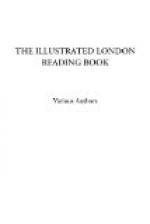From the moment Mary of Scotland took the fatal resolution of throwing herself upon the supposed kindness and generosity of Elizabeth, her fate was sealed, and it was that of captivity, only to be ended by death. She was immediately cut off from all communication with her subjects, except such as it was deemed proper to allow; and was moved about from place to place, the better to ensure her safety. The hapless victim again and again implored Elizabeth to deal generously and justly with her. “I came,” said she, in one of her letters, “of mine own accord; let me depart again with yours: and if God permit my cause to succeed, I shall be bound to you for it.” But her rival was unrelenting, and, in fact, increased the rigours of her confinement. Whilst a prisoner at Chatsworth, she had been permitted the indulgence of air and exercise; and the bower of Queen Mary is still shown in the noble grounds of that place, as a favourite resort of the unfortunate captive. But even this absolutely necessary indulgence was afterwards denied; she was wholly confined to the Castle of Fotheringay, and a standing order was issued that “she should be shot if she attempted to escape, or if others attempted to rescue her.”
[Illustration: QUEEN MARY’S BOWER, AT CHATSWORTH.]
Burns, in his “Lament of Mary, Queen of Scots,” touchingly expresses the weary feelings that must have existed in the breast of the Royal captive:—
“Oh, soon to me may
summer suns
Nae mair light
up the morn!
Nae mair to me the autumn
winds
Wave o’er
the yellow corn!
And in the narrow house of
death,
Let winter round
me rave;
And the next flowers that
deck the spring,
Bloom on my peaceful
grave.”
* * * * *
TUBULAR RAILWAY BRIDGES.
In the year 1850, a vast line of railway was completed from Chester to Holyhead, for the conveyance of the Royal mails, of goods and passengers, and of her Majesty’s troops and artillery, between London and Dublin—Holyhead being the most desirable point at which to effect this communication with Ireland. Upon this railway are two stupendous bridges, which are the most perfect examples of engineering skill ever executed in England, or in any other country.
The first of these bridges carries the railway across the river Conway, close to the ancient castle built by Edward I. in order to bridle his new subjects, the Welsh.
The Conway bridge consists of a tube, or long, huge chest, the ends of which rest upon stone piers, built to correspond with the architecture of the old castle. The tube is made of wrought-iron plates, varying in thickness from a quarter of an inch to one inch, riveted together, and strengthened by irons in the form of the letter T; and, to give additional strength to the whole, a series of cells is formed at the bottom




